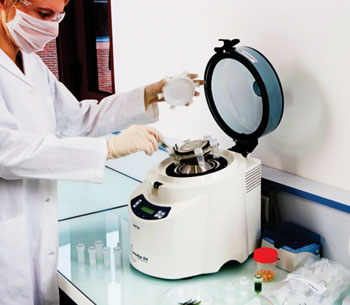Tissue Microbiological Diagnostics Improved by High-Throughput Homogenizer
By LabMedica International staff writers
Posted on 09 Jul 2015
Tissue specimens are valuable materials for microbiological diagnostics and require swift and accurate processing but established processing methods are complex, labor intensive, hardly if at all standardizable, and prone to incorporate contaminants.Posted on 09 Jul 2015
To improve analyses from tissue samples in routine microbiological diagnostics, by facilitating, fastening, and standardizing processing as well as increasing the microbial yield, the performance of high-throughput tissue homogenizer has been evaluated.

Image: The Precellys 24 high-throughput homogenizer for tissue microbiological diagnostics (Photo courtesy of Bertin Technologies).
Medical microbiologists at the Rostock University Hospital (Germany) tested tissue samples that were artificially inoculated with Staphylococcus aureus, Escherichia coli, and Candida albicans in three different ways on the surface and within the material. Microbial yield from homogenized samples was compared to direct plating method. Tissue samples from seven patients with knee or hip endoprosthesis infections were obtained during surgical removal of the potentially infected prosthesis. Specimens were obtained from the periprosthetic membranes as well as from the synovia of the affected joint.
Overall, 22 patient samples were analyzed and each tissue specimen was cut into four pieces under sterile conditions. Two of these pieces were used for routine diagnostics including solid Columbia agar, chocolate agar, and Schaedler agar, and broth (BHI) media culture techniques. For homogenization of the samples, the Precellys 24 high-throughput homogenizer (Bertin Technologies, Rockville, MD, USA) was used.
The 22 tissue samples from knee and hip endoprosthesis infections were microbiologically analyzed by direct plating and after homogenization, in parallel to a routine diagnostic approach. From 17 samples, no microorganisms could be grown, but five were positive with culture techniques, revealing S. aureus in four instances and Staphylococcus capitis in one instance from both direct plating or homogenizing approach as well as by routine diagnostic techniques.
The authors concluded that homogenization of tissue samples with Precellys 24 high-throughput tissue homogenizer significantly augments the recovered microbiological quantities compared to direct plating. Improvement in quantitative recovery from tissues could be demonstrated for Gram-positive bacteria, Gram-negative bacteria, and fungi. Better recovery of microorganisms by homogenization was independent from the location of the microorganisms on or within the tissue. Furthermore, up to 24 samples can be simultaneously homogenized within little expenditure of time in a standardized fashion supporting its applicability under routine conditions. The study was published in the July, 2015 issue of the journal Diagnostic Microbiology and Infectious Disease.
Related Links:
Rostock University Hospital
Bertin Technologies













